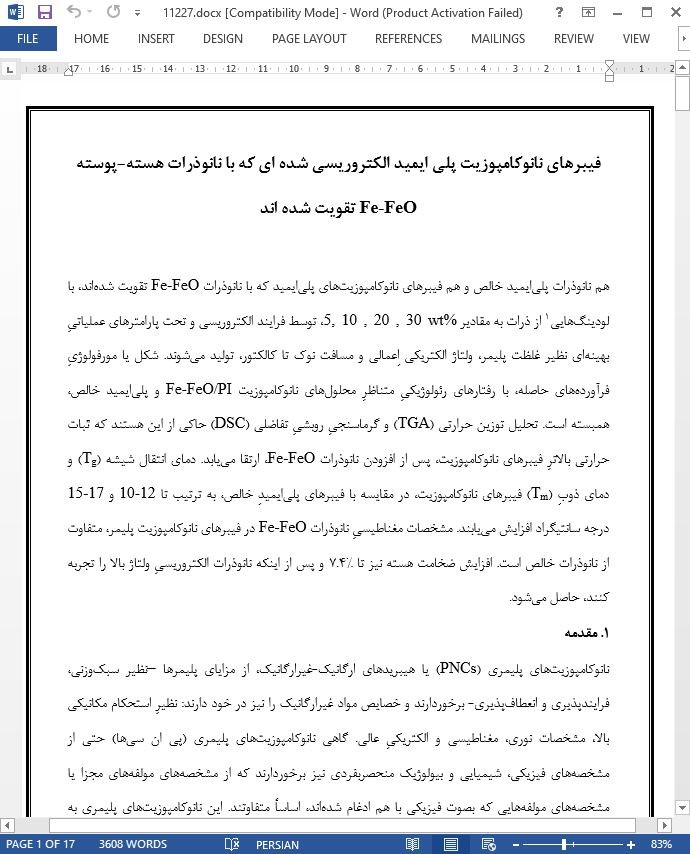
فیبرهای نانوکامپوزیت پلی ایمید الکتروریسی شده ای که با نانوذرات هسته-پوسته Fe-FeO تقویت شده اند
هم نانوذرات پلیایمید خالص و هم فیبرهای نانوکامپوزیتهای پلیایمید که با نانوذرات Fe-FeO تقویت شدهاند، با لودینگهایی از ذرات به مقادیر 5, 10 , 20 , 30 wt%، توسط فرایند الکتروریسی و تحت پارامترهای عملیاتیِ بهینهای نظیر غلظت پلیمر، ولتاژ الکتریکی اِعمالی و مسافت نوک تا کالکتور، تولید میشوند. شکل یا مورفولوژیِ فرآوردههای حاصله، با رفتارهای رئولوژیکیِ متناظرِ محلولهای نانوکامپوزیت Fe-FeO/PI و پلیایمید خالص، همبسته است. تحلیل توزین حرارتی (TGA) و گرماسنجیِ روبشیِ تفاضلی (DSC) حاکی از این هستند که ثبات حرارتی بالاترِ فیبرهای نانوکامپوزیت، پس از افزودن نانوذرات Fe-FeO، ارتقا مییابد. دمای انتقال شیشه (Tg) و دمای ذوبِ (Tm) فیبرهای نانوکامپوزیت، در مقایسه با فیبرهای پلیایمیدِ خالص، به ترتیب تا 10-12 و 15-17 درجه سانتیگراد افزایش مییابند. مشخصات مغناطیسیِ نانوذرات Fe-FeO در فیبرهای نانوکامپوزیت پلیمر، متفاوت از نانوذرات خالص است. افزایش ضخامت هسته نیز تا 7.4% و پس از اینکه نانوذرات الکتروریسیِ ولتاژ بالا را تجربه کنند، حاصل میشود.
1. مقدمه
نانوکامپوزیتهای پلیمری (PNCs) یا هیبریدهای ارگانیک-غیرارگانیک، از مزایای پلیمرها –نظیر سبکوزنی، فرایندپذیری و انعطافپذیری- برخوردارند و خصایص مواد غیرارگانیک را نیز در خود دارند: نظیرِ استحکام مکانیکی بالا، مشخصات نوری، مغناطیسی و الکتریکیِ عالی. گاهی نانوکامپوزیتهای پلیمری (پی ان سیها) حتی از مشخصههای فیزیکی، شیمیایی و بیولوژیک منحصربفردی نیز برخوردارند که از مشخصههای مولفههای مجزا یا مشخصههای مولفههایی که بصوت فیزیکی با هم ادغام شدهاند، اساساً متفاوتند. این نانوکامپوزیتهای پلیمری به دلیل کاربردهای بالقوهای که در دستگاههای ذخیرهی انرژی، الکترونیک، جاذبهای ریزموج و حسگرها دارند، هم در حوزههای دانشگاهی و هم در حوزههای صنعتی، توجه زیادی را به خود معطوف کردهاند.
4. نتیجه
پلیایمید خالص و فیبر نانوکامپوزیتهای Fe-FeO/PI با الکتروریسی تهیه میشوند. پژوهشهایی نظاموند روی اثرات غلظت پلیمر، ولتاژ شتاب، مسافت نوک تا کالکتور بر شکل و توزیع سایز فیبرها انجام گرفته است. ولتاژ بالاتری برای ساخت فیبرهای نانوکامپوزیت در مقادیر بالای لودینگهای نانوذره مورد نیاز است، دلیلش هم افزایش ویسکوزیتهی محلولهای نانوکامپوزیت است. نتایج TGA و DSC بیانگر ثبات حرارتی بیشتر با دمای بیشترِ انتقال شیشهی فیبرهای نانوکامپوزیت در مقایسه با فیبرهای پلیایمید خالص میباشند. نانوذرات در فیبرهای نانوکامپوزیت، بلحاظ مغناطیسی سختتر میشوند و افزایش معنادارتری در وادارندگیشان حاصل میشود: از 62.3 Oe به 188.2 Oe . افزایش حدوداً 7.4 درصدی در ضخامت پوستهی نانوذره، طی فرایند ساخت فیبر با ولتاژ بالا و به شیوهی الکتروریسی رخ میدهد.
Both pure polyimide (PI) and Fe-FeO nanoparticles reinforced PI nanocomposite fibers with a particle loading of 5, 10, 20, and 30 wt % are produced by electrospinning with optimized operational parameters such as polymer concentration, applied electrical voltage, and tip-to-collector distance. The morphology of the resulting products is correlated to the corresponding rheological behaviors of the pure PI and Fe-FeO/PI nanocomposite solutions. Thermogravimetric analysis (TGA) and differential scanning calorimetry (DSC) reveal an enhanced thermal stability of the nanocomposite fibers after introducing the Fe-FeO nanoparticles. The glass transition temperature (Tg) and melting temperature (Tm) of the nanocomposite fibers increase by 10−12 and 15−17 °C, respectively, as compared to those of the pure PI fibers. The magnetic properties of the Fe-FeO nanoparticles in the polymer nanocomposite fibers are different from those of the as-received nanoparticles. An increased shell thickness by 7.4% is deduced after the nanoparticles experiencing the high-voltage electrospinning.
1. Introduction
Polymer nanocomposites (PNCs) or organic-inorganic hybrids attain the advantages of the polymers such as light weight, easy processability, and flexibility, and introduce the propensity of the inorganic materials such as high mechanical strength and excellent electrical, magnetic, and optical properties. Sometimes, PNCs even possess unique physical, chemical, or biological properties, which are essentially different from those of the components taken separately or physically combined properties of each component. These PNCs have attracted wide interest in both academic and industrial fields for their diverse potential applications in energy storage devices,1 electronics,2,3 microwave absorbers,4,5 and sensors.6
4. Conclusion
Pure PI and Fe@FeO/PI nanocomposites fibers are produced by electrospinning. The effects of polymer concentration, acceleration voltage, and tip-to-collector distance on the morphology and size distribution of the fibers are systematically studied. Higher voltage is required for the fabrication of nanocomposite fibers at high nanoparticle loadings owning to the increased viscosity of the nanocomposite solutions. TGA and DSC results indicate an enhanced thermal stability with an increased glass transition (Tg) temperature of the nanocomposite fibers as compared to that of the pure PI fibers. The nanoparticles in the nanocomposites fibers become magnetically harder with a significant increase of coercivity from 62.3 Oe (as-received Fe@FeO nanoparticles) to 188.2 Oe. Meanwhile, an increase of about 7.4% in the nanoparticle shell thickness is deduced during the high-voltage electrospinning fiber fabrication process.
1. مقدمه
2. بخش آزمایشی
2.1 مواد
2.2 آمادهسازیِ پلیایمید و محلولهای نانوکامپوزیت
2.3 ساخت فیبرهای پلیایمید طبیعی و فیبرهای نانوکامپوزیت
2.4 ویژگیشماری (ذکر ویژگیها)
3. نتایج و بحث و تبادل نظر
3.1 ریزساختارِ فیبرهای پلیایمید خالص 3.1.1. اثر غلظت پلیمر
3.2 ریزساختار فیبرهای نانوکامپوزیت Fe-FeO/PI
3.3 تحلیل FT-IR
3.4 تحلیل DSC(گرماسنجی روبشیِ تفاضلی).
3.5 تحلیل توزین حرارتی (TGA)
3.6 مشخصهی مغناطیسی
4. نتیجه
1. Introduction
2. Experimental Section
2.1. Materials
2.2. Preparation of Polyimide and Nanocomposite Solutions
2.3. Fabrication of Pristine PI and Nanocomposite Fibers
2.4. Characterization
3. Results and Discussion
3.1. Microstructure of Pure Polyimide Fibers. 3.1.1. Polymer Concentration Effect
3.2. Microstructure of Fe-FeO/PI Nanocomposite Fibers
3.3. FT-IR Analysis
3.4. DSC Analysis
3.5. Thermogravimetric Analysis (TGA)
3.6. Magnetic Property
4. Conclusion
- اصل مقاله انگلیسی با فرمت ورد (word) با قابلیت ویرایش
- ترجمه فارسی مقاله با فرمت ورد (word) با قابلیت ویرایش، بدون آرم سایت ای ترجمه
- ترجمه فارسی مقاله با فرمت pdf، بدون آرم سایت ای ترجمه



